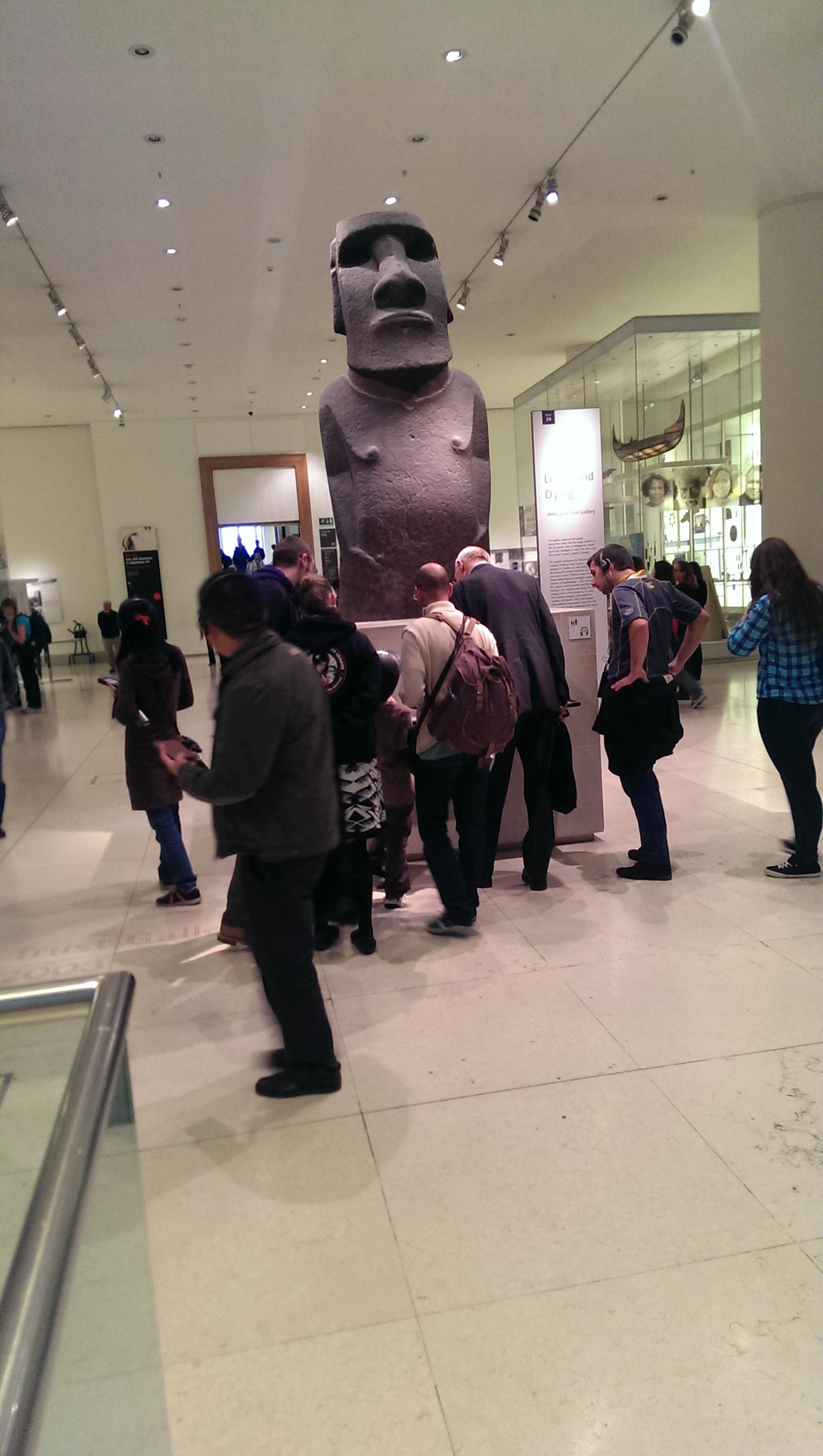
This post has been a long time in coming, it is something I have been thinking about for a little while now. Ideas have come from lots of different people that have shed light on my thoughts and connected them up. There is certainly something to be said for giving a post a little bit of time, time to develop and evolve, time to contemplate and ruminate. I guess that is what this post is all about really, time, giving yourself time.
I am not sure when it all began. I think three things happened around the same time. I went to the David Bowie exhibition at the V&A with a friend. It is a funny thing to visit a museum exhibit with a friend for the first time. It is kind of like going running with someone for the first time. Are you in sync? Do you stay together and look at each exhibit in tandem, read each label and chat as you explore or do you split up and get lost in your own thoughts. Then meet up at the end to review and critique. Are you a browser or a very thorough devotee who has to read every label?
I stood in front of the first item in the Bowie exhibition, looked up and my friend was gone. Was I really reading that slowly and taking too long? I had a little panic, was she bored of waiting for me, should I speed up? I started to fly by the pictures on the wall, my eyes furtively searching for her. It was only when I caught up with her in the final room that I discovered she like to go to the end of an exhibition and work her way forward, she often felt it was quieter that way, particularly with timed tickets when lots of people enter at the same time. It made me begin to think about how we look at objects, how long we take to read labels and to really see the objects in front of us.
In the playground I got chatting to my neighbour’s mother, she was fulfilling her grandmotherly duties, over from Ireland to take the kids to school for a week. She was an artist, fascinating to talk to, she didn’t mind the early starts and wrestling with book bags and pack lunches. As soon as the kids were in school she was off to the National Portrait Gallery where she would sit in front of one portrait for most of the day to try and draw it. To recreate the curve of an arm, the slant of shoulder, the curled fingers. It was her way to really understand a picture and an artist. I thought ‘I don’t do this’, I may not be an artist but I don’t sit and really look at one object for any length of time, to understand it, how it was made, was it difficult, what was it for, what it says about a people or a culture. I am often rushing, scanning, skimming past objects, snapping a photo, watching the clock, time to move on, more to see and more to do.
I noted with interest the report by Linda Henkel on taking photos in museums and how they affect your memory. How taking a photo allows you to engage with the object creating a connection. But how long do we take to look at objects? How does that affect our recall and memories?
Finally it was my son that really made me think about how we look at objects in museums. As ever, watching a child in a museum is the most fascinating, enlightening and amazing experience. It surprises me every time and allows me to open my eyes to objects they way a child does. They come to objects and museums spaces with fresh eyes, enquiring, open and unencumbered by preconceptions or tainted by a lifetimes connections and straightjacket knowledge of what we see in front of us.
I took my 3 year old up to the British Museum, a bit optimistic on my part really. By the time we have dropped his sisters at school, taken a bus, train and tube to get there I actually only have about 20 minutes to take him round the museum before he is tired, or hungry, or it is time for a toilet stop or time for a tantrum. He kind of uses up all his energies and focus on the bus and the train and the tube and who can blame him when it is new and fresh and exciting.
So what do you do if you have maybe 20 minutes in a museum if you are lucky? Focus on one room, rush round one gallery, or just wander and meander letting little feet take you where they will. On this particular trip we were in the Great Court and suddenly me son stopped in a door way transfixed, he rushed off leaving me behind. He had seen Dum Dum. This might not mean a lot to you but if I were to say Easter Island head or Moai you would have a clearer idea of what had caught his attention.

If you have seen the film ‘Night at the Museum’ then you will know a Moai features in it and he says to Ben Stiller’s character “Hey Dum Dum! You give me gum gum” I won’t explain more, you need to see it for yourself. But somehow these strange Moai have ended up being called ‘Dum Dum’ in our house. In fact we have our own Dum Dum, one my Mother made for us at her pottery class. He sits in the garden with grasses growing out of his head.

As soon as you start to make associations and connect with objects they seem to have a magical power to pop up in every aspect of your life. Before we even watched the film when I took my youngest for a walk we came across a Moai type figure in someones front garden. We got in the habit of stopping to wave hello, we called him Stone Man.

We were at the garden centre and saw a small replica of the Maoi that was supposed to go in a fish tank, we bought it as a thank you to my mother for her time and effort in making our garden Dum Dum. Her version wears a natty blue bow but I don’t think she has given him a pet name.

So my son had found his Dum Dum, a massive lump of stone, a weird basalt giant, strange and yet so familiar to him. He stood stock still in front of it, taking it all in, he knew it was Dum Dum but not the Dum Dum he was used to. This one so much bigger, perhaps a bit scarier, I am not sure if he was waiting for it to talk to him or move. He ended up running round and round him, pointing up and chatting away, so happy to have found this familiar yet strange object. I think we must have spent most of our 20 golden minutes standing there looking up at this thing. I had to take a picture on my phone, when we got home he took great pride and joy in showing his Daddy and sisters that he had seen Dum Dum.

We went all the way to the British Museum and we saw one object, how many thousands may be in the galleries and rooms, in glass cabinets and out on display? But we saw one, just one. Was our trip a failure? Did we miss all the opportunities laid out before us? Or did we actually have the most magical time, one that my son won’t forget, a trip that has forged strong connections in his life with spaces known at home and spaces unknown at the museum. He is seeing that objects that exist in television, films and make-believe can be discovered in outside spaces, in your back garden, in fish tanks(!), at Nanny’s house and in a museum. Objects can be known and familiar and yet different and strange.
When I was next in the British Museum I was rushing through the Great Court, a million and one things to do and suddenly through the doorway Dum Dum caught my eye. I did what my son had taught me to do. I stopped and stood in front of this amazing object. Yes I read a label and took a snap or two. But I also stood stock still and looked. I walked slowly round and admired the surface, the sunken eyes, the slope of the arms, the fingers protective.

I thought about the work involved to make this object, to raise it up, what it meant to the people of Rapa Nui (Easter Island), how it had travelled to the British Museum.

As I turned to the back of Hoa Hakananai’a I saw the carvings I had never noticed before, messages and markers, to tell a story, give meaning, I could make out strange faces and I was left mystified by strange symbols.

My children often show me the way. They make me see things I haven’t really seen before. They open my eyes and help me see things anew. Since that day I have been back many times to visit Hoa Hakananai’a, I have investigated further and I am even more intrigued.
I know that Hoa Hakananai’a means stolen or hidden friend, I know when found the statue was buried up to its shoulders in the earth. I have read about the birdman religion and how the carvings on the back refer to its sacred rituals. That originally the face was painted white and the carvings on the back red. I know that two statues were brought from Rapa Nui on the HMS Topaze, Hoa Hakananai’a and Moai Hava. I absolutely love the fact they originally stood in the British Museum portico from when they arrived in 1869 right through to 1940. It must have been an amazing site. I can’t imagine what people thought of these strange proud faces when they arrived at the Royal Victoria Naval Yard in Deptford. This has led me on to find pictures of Moai Hava, it looks quite different face upturned to the skies. Currently on loan to the World Museum in Liverpool.
There are many other things I have learnt. All this from my son running up to his Dum Dum and teaching me to look at one object at a time. I have learnt more about that object than any other in the British Museum and all because I gave myself the time to do it. I hope one day Hoa Hakananai’a and Moai Hava will be reunited at the British Museum, maybe in the Great Court for all to see. You can bet if that happens I will give myself time to visit them both, I will sit and look and maybe even try and draw them. I will take my little boy and see what he makes of them.
I may not have time to visit each and every object in the British Museum, but I know that this one object is special to me, I pay homage every time I visit the British Museum, it has become part of my history and all because I looked through the eyes of my child and gave myself time to see what he saw.
xxxxxxxxxxxxxx
You can find Hoa Hakananai’a in Room 24 – Living and Dying just off the Great Court in the British Museum
British Museum highlights page of Hoa Hakananai’a British Museum Online collections page on Hoa Hakananai’a British Museum Online collections page on Moai Hava
You can also listen to the British Museum – A history of the World in 100 objects – Hoa Hakananai’a I enjoyed reading this a good short introduction – J. Van Tilburg, Hoa Hakananaia (London, British Museum Press, 2004)
You can find Moai Hava at the World Museum Liverpool till May 2015 World Museum Liverpool blog on Moai Hava








